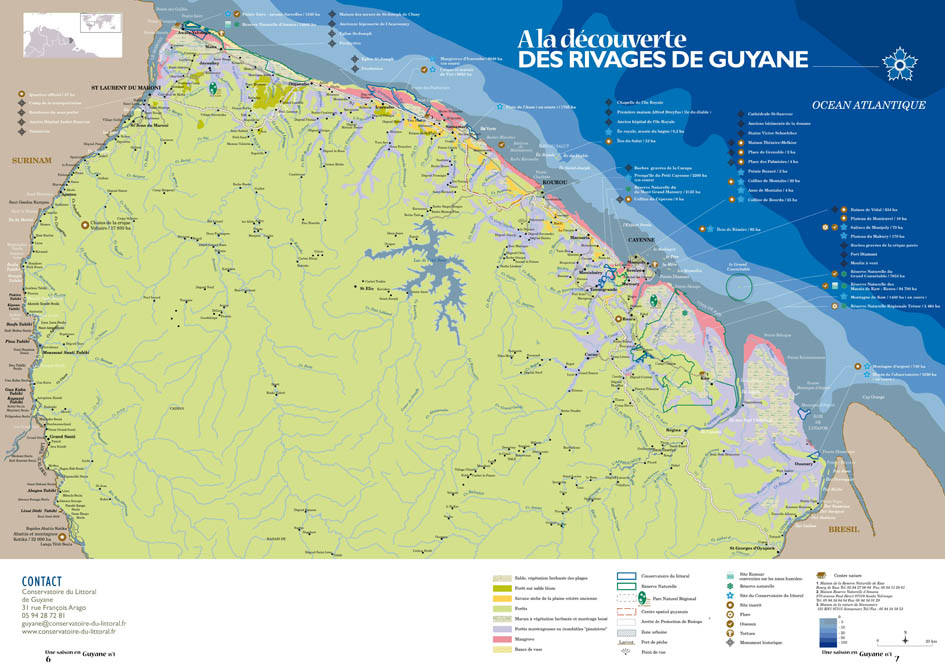French Guiana’s coastline is over 300 kilometres long and made up primarily of all but inaccessible virgin mangrove forests, with the exception of a few rocky outcrops which have been built on, such as the Cayenne Peninsula and the estuary of the River Kourou. The rivers flow into the Atlantic Ocean down vast estuaries that cut deep into the coastline.
One of the prime characteristics of this coastline is that it is continually shifting due to the enormous volumes of sediment washed down from the Amazon.
The environment is still home to a rich biodiversity of flora and fauna thanks to the low level of human pressure. Globally significant species live here or else come to gather or reproduce on the Guyanese coast, such as leatherback turtles, one of whose largest breeding sites in the world is on the estuary of the River Maroni, and red ibis, which were previously threatened by the local craft industry, and hundreds of thousands of migrating waders.
The Coastal Conservation Authority (Conservatoire du Littoral) oversees a land use policy to protect the coastal and lakeside areas. It buys up land to protect it from various sorts of pressure, such as urbanisation or deforestation. It works alongside municipal councils and other concerned partners.
The Conservation Authority seeks to develop appropriate policies to protect the coastline, be it in the vast, virtually untouched spaces or in zones of intense urban pressure. The wildlife in the immense and difficult to reach areas needs to be better understood and protected, and the magnificent landscapes of the coastal islands steeped in history deserve to be rediscovered. Lastly, urbanisation needs to be halted in the cramped peri-urban natural spaces, which should be opened up to leisure and educational activities by creating non-intrusive facilities for the public.
The Conservation Authority works to protect a network of coastal nature sites subjected to intense urban pressure that are dotted along the Cayenne Peninsula coast. These are easy to get to and provide islands of greenery and recreational areas for everybody to explore sites just outside the towns.
Facilities such as discovery trails have already been put in place, including the new Montabo trail, the Mont Bourda trail, and the visitor facilities at the Salines de Montjoly.




 English
English Français
Français  Português
Português 

 You can zoom inside the map with your mouse wheel.
You can zoom inside the map with your mouse wheel. 
 Télécharger l'article en PDF est réservé aux abonnés Web !
Télécharger l'article en PDF est réservé aux abonnés Web !  Voyages avec Tooy. Histoire, mémoire, imaginaire des Amériques noires : Editions Vents d’ailleurs, 2010
Voyages avec Tooy. Histoire, mémoire, imaginaire des Amériques noires : Editions Vents d’ailleurs, 2010
 Guyane. Produits du terroir et recettes traditionnelles. L’inventaire du patrimoine culinaire de la France : Editions Albin Michel, 1999
Guyane. Produits du terroir et recettes traditionnelles. L’inventaire du patrimoine culinaire de la France : Editions Albin Michel, 1999
 Alunawalé, un voyage à travers les milieux naturels de Guyane : Office National des Forêts, 2009
Alunawalé, un voyage à travers les milieux naturels de Guyane : Office National des Forêts, 2009
 Augusta Curiel, Fotografe in Suiriname 1904 – 1937 : Libri Misei Surinamensis, 2007
Augusta Curiel, Fotografe in Suiriname 1904 – 1937 : Libri Misei Surinamensis, 2007

 Pas de réaction
Pas de réaction Comment!
Comment!



